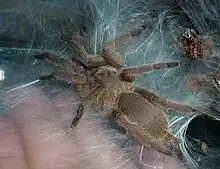Chilobrachys huahini
Chilobrachys huahini also known as the Asian fawn, Hauhini bird spider or Hauhini birdeater tarantula[1] is a tarantula which was first described in 1996 by Gunter Schmidt and Siegfried Huber. It is named after Hua Hin, Thailand as it is found there.
| Chilobrachys huahini | |
|---|---|
 | |
| Scientific classification | |
| Domain: | Eukaryota |
| Kingdom: | Animalia |
| Phylum: | Arthropoda |
| Subphylum: | Chelicerata |
| Class: | Arachnida |
| Order: | Araneae |
| Infraorder: | Mygalomorphae |
| Family: | Theraphosidae |
| Genus: | Chilobrachys |
| Species: | C. huahini |
| Binomial name | |
| Chilobrachys huahini Schmidt & Huber, 1996 | |
Description
Females live 11 to 12 years, while males live 2 to 4.[1] Their bodies are all around brown, with some darker stripping in the carapace and legs. Males are a bit lighter than the females, though their coloration is still brown.
Habitat
It is found in Hua Hin, which is home to a tropical savanna climate. With average temperatures of 28°C, and average yearly rainfall of 955mm.[2] It is home to plants such as Dipterocarpus tuberculatus and Hopea odorata. It is also home to animals such as Gaurs, Asian elephants and Golden Jackals.[3]
Behavior
It is a terrestrial tarantula, but is also an opportunistic burrower. They are very defensive, and are quite skittish, it is quite fast, and persistent provocation may result in a bite. As they are old world tarantulas, they do own potentially significant venom.[4]
References
- "Chilobrachys huahini-Asian Fawn | My Monsters". Retrieved 2022-06-20.
- "CLIMATOLOGICAL DATA FOR THE PERIOD 1981-2010". Climate TMD. Retrieved June 20, 2022.
- "Kui Buri National Park". Thai National Parks. Retrieved 2022-06-20.
- Crinoa (2011-04-11). "Tarantula and Scorpion Handler's Blog: Chilobrachys Tarantua specie Caresheets". Tarantula and Scorpion Handler's Blog. Retrieved 2022-06-20.